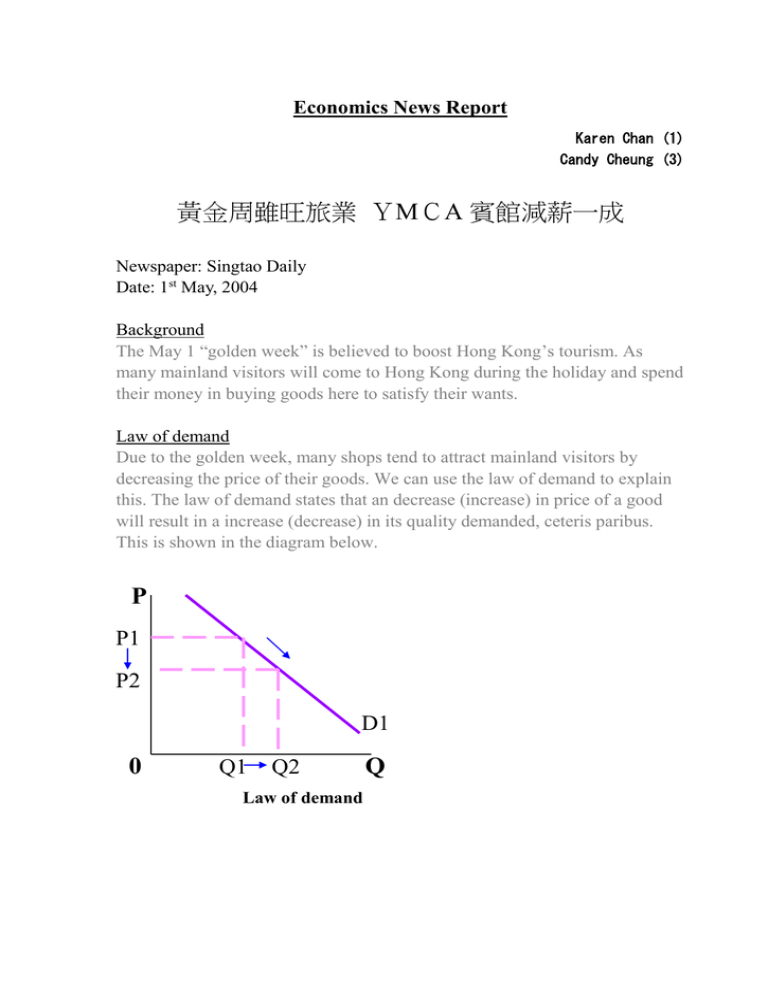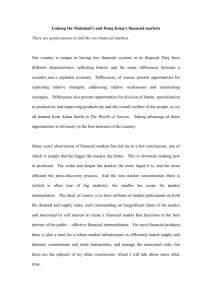Karen Chan
advertisement

Economics News Report Karen Chan (1) Candy Cheung (3) 黃金周雖旺旅業 YMCA 賓館減薪一成 Newspaper: Singtao Daily Date: 1st May, 2004 Background The May 1 “golden week” is believed to boost Hong Kong’s tourism. As many mainland visitors will come to Hong Kong during the holiday and spend their money in buying goods here to satisfy their wants. Law of demand Due to the golden week, many shops tend to attract mainland visitors by decreasing the price of their goods. We can use the law of demand to explain this. The law of demand states that an decrease (increase) in price of a good will result in a increase (decrease) in its quality demanded, ceteris paribus. This is shown in the diagram below. P P1 P2 D1 0 Q1 Q2 Law of demand Q Revenue of hotels During the golden week, many mainland visitors will come to Hong Kong. They will need to stay in hotels, so the demand for hotels increase. P S P2 X GAIN P1 D2 Y D1 0 Q (Hotels) The supply of hotel rooms is fixed. The demand curve shifts to the right. Price increases from P1 to P2 and quantity transacted remains unchanged. The total revenue of hotels increases from (P1 x Q) to (P2 x Q). Wages payment for hotel workers Workers’ wages are paid according to the length of time worked. This wage payment is used because it is difficult to measure the contributions of workers working in a hotel. The advantages of using time rate is that to the employer, it is simple and easy to administer. And workers can have a stable income. The risk of income fluctuation is reduced. There are some disadvantages; the employer’s cost of supervising the workers is higher. Also, as workers income doesn’t depend on the output produced, their working incentive will be weaker. Therefore, profit sharing scheme is carried out. Under the profit sharing scheme, a certain percentage of profit is given to the workers as a year-end bonus. Workers with better performance will get more, so this could increase workers working incentive. However, they will get no bonus if the hotel makes no profit. Case of workers’ wages Nowadays the economic condition is poor, many people lose their jobs. There is unemployment. This is shown in the diagram. The market price (P1) is higher than the equilibrium wage (Pe). Quantity supplied is larger than quantity demanded. There is excess supply of workers. P Excess Supply1 S P1 Pe D 0 Q Qd Workers < Qs Decrease of workers wages Golden week attracts many mainland tourists to Hong Kong, therefore hotels demand more workers to serve the increasing numbers of tourists. There is increase in demand for workers. Demand curve shifts to the right. At P1, excess supply decreases. This reduces unemployment. Excess Supply 2 P Excess Supply 1 S P1 Pe D2 D1 1 Q Workers In order to further reduce the excess supply, the wage rate of the workers should decrease to meet the equilibrium. Then there will be no excess supply. However, the workers’ wages would have to decrease. = The End =




